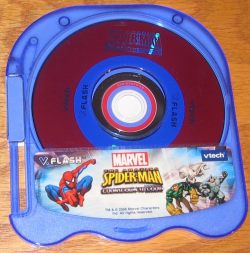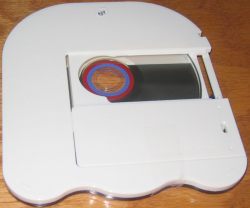So I went out and got one of those V.Discs that operate with the VTech V.Flash console: The Amazing Spider-Man: Countdown To Doom. This is what it looks like, front and back (click for larger pictures):


The door in the back is spring-loaded; I taped it open for the photo shoot. Now I just need a good way to get the cartridge open, hopefully by employing a method somewhat more sophisticated than my first impulse– bang with rock. I’m not really worried about getting the disc back into the cartridge. But it would be nice to ensure that the optical disc is not damaged during the process. Even if I get a cheap V.Flash console somewhere down the line, it stands to reason that the disc can be placed in the audio CD tray and played. Though there could be some mechanism to prevent that– perhaps the cartridge design trips some switch in the console authorizing the disc as an actual bootable game. The game’s instruction manual warns of the legal ramifications of copying and claims that backup or archival copies are legally prohibited. So, the manual tacitly acknowledges that copying is somehow possible.
Studying the remainder of the manual as well as the box copy, I see no other companies involved other than VTech (and the myriad license holders of the properties advertised). So I imagine that VTech develops all the software in-house.
As an aside, when it comes to children’s toys, I have really been out of it for the last, oh, 17 years or so. When wandering down the toy aisle containing the VTech products, I was stunned by the volume of tech-y kids toys. I guess it’s a good business model– sell some kind of cheap base system and then sell lots of media. And I don’t know what I was thinking in my previous post when I expressed amazement at VTech’s licensee lineup for the V.Flash– these companies will whore their properties to just about anyone, as my trip to the toy aisle revealed (e.g., Disney for every no-name gizmo system). But as long as a system uses optical media and probably displays FMV, you know I’ll be interested.
Obligatory MultimediaWiki page: It’s not much more impressive than the current English Wikipedia page.


